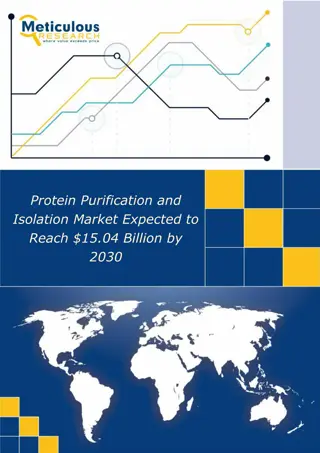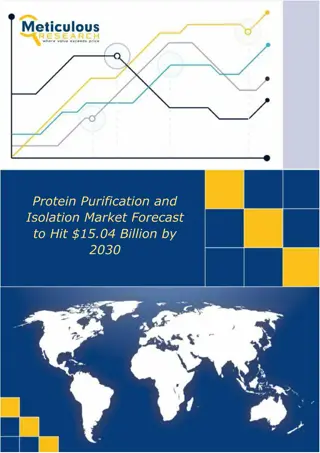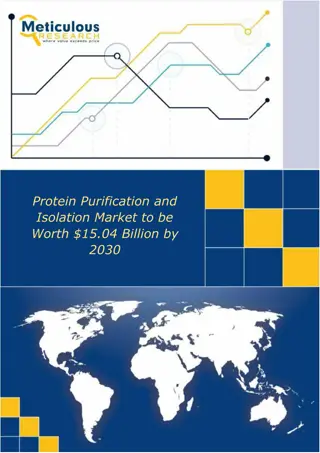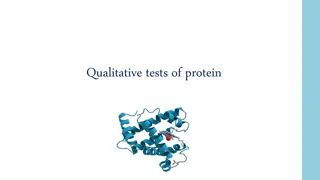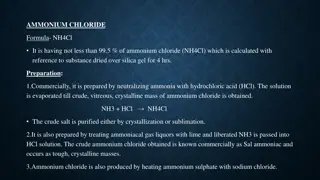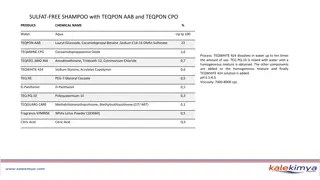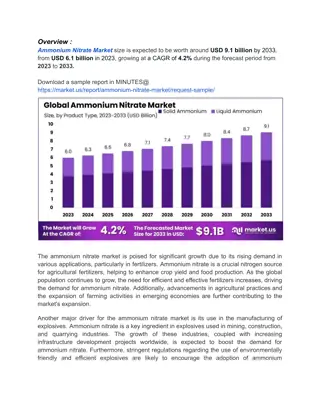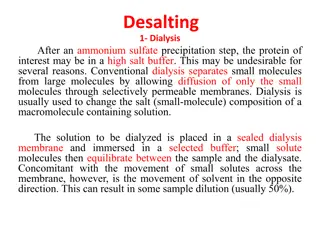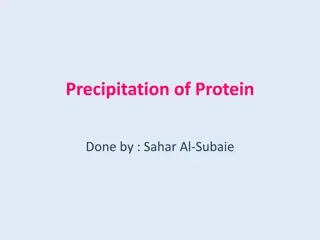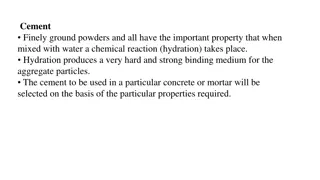Protein Purification Techniques and Ammonium Sulfate Precipitation
Protein purification is a crucial process in biotechnology to isolate specific proteins from complex mixtures. Techniques such as exploiting physio-chemical properties, binding affinity tags, and biological activity are used. Ammonium sulfate precipitation, a common first step, involves adding increasing amounts of the compound to protein extracts to induce protein aggregation and precipitation. This cost-effective method helps in the purification of proteins from diverse sources.
Download Presentation

Please find below an Image/Link to download the presentation.
The content on the website is provided AS IS for your information and personal use only. It may not be sold, licensed, or shared on other websites without obtaining consent from the author.If you encounter any issues during the download, it is possible that the publisher has removed the file from their server.
You are allowed to download the files provided on this website for personal or commercial use, subject to the condition that they are used lawfully. All files are the property of their respective owners.
The content on the website is provided AS IS for your information and personal use only. It may not be sold, licensed, or shared on other websites without obtaining consent from the author.
E N D
Presentation Transcript
Lecture 14 Lecture 14 February 23, 2016 Biotech 3
Protein Purification Protein Purification A process intended to isolate one or more proteins from a mixture, usually from cells or whole tissue extracts. Exploit protein properties for purification purposes. 1. Physio-chemical properties charge or hydrophobicity 2. Binding affinity Tags 3. Size large or small 4. Biological activity Substrate analogs
Protein Purification Protein Purification - - Preparation Preparation Secreted or not secreted? Secreted Purify protein from cell growth cell media Not secreted (intracellular) Extract protein from cell culture 1. Repeated freeze thaw cycles 2. Sonication 3. Homogenization by high pressure (French press 4. Homogenization by grinding (bead mill) 5. Permeabilization by detergents (e.g. Triton X-100) and enzymes (e.g. lysozyme) Collect pellet if insoluble Centrifuge Collect supernatant if soluble
Ammonium Sulfate Precipitation Ammonium Sulfate Precipitation Common 1st step in protein purification. Add increasing amounts of ammonium sulfate to protein extract. Exposes hydrophobic groups on the protein. Hydrophobic groups attract other protein hydrophobic groups. Results in aggregation of protein. Protein precipitates from solution. Inexpensive. Reversible aggregation!!
Ammonium Sulfate Ammonium Sulfate Precipitation Steps Precipitation Steps
Ammonium Sulfate Precipitation Ammonium Sulfate Precipitation Step 1 Step 1 1. Add ammonium sulfate - Must perform on ice! - Increments of percent of saturation example) - 10%, 20%, 30% etc.
Ammonium Sulfate Precipitation Ammonium Sulfate Precipitation Step Step 1 Cont. 1 Cont. Protein aggregates and precipitates out from solution
Ammonium Sulfate Precipitation Ammonium Sulfate Precipitation Step 2 Step 2
Ammonium Sulfate Precipitation Ammonium Sulfate Precipitation Step Step 3 3
Ammonium Sulfate Precipitation Ammonium Sulfate Precipitation Step Step 4 (repeat 1 4 (repeat 1- -3) 3) 30 % Continue process: 40%, 50%, 60%...etc.
Ammonium Sulfate Ammonium Sulfate Precipitation Example Precipitation Example Step Pellet - total protein (mg) Supernatant - total protein (mg) Pellet - total enzyme activity Supernatant - total enzyme activity Crude extract 6000 - 2000 10% (NH4)2SO4 100 5900 0 2000 20% (NH4)2SO4 1000 4900 100 1900 30% (NH4)2SO4 1000 3900 500 1400 50% (NH4)2SO4 800 3100 800 600 70% (NH4)2SO4 800 2300 500 100 80% (NH4)2SO4 1000 1300 100 0 Simple Pellets can be added together Removes nonprotein molecules not seen in table
Protein Purification Protein Purification - - Chromatography Chromatography 1.Affinity 2.Ion Exchange 3.Hydrophobic interaction 4.Size exclusion 5.Reverse phase
1. Affinity Chromatography 1. Affinity Chromatography Separates proteins based on specific interaction. Reversible interaction High selectivity High resolution High capacity Can obtain several 1000-fold purity Example: Metal ion Affinity Chromatography Chelates metal ions such as Ni2+ (Co2+ , Cu2+, Zn2+)
Metal Chelating Metal Chelating NTA and 6XHis Tag NTA and 6XHis Tag Pictured: Nitrilo triacetic acid (NTA) Alternatives: nitrile triacetic acid (IDA) Tris carboxymethyl ethylene diamine (TED) Polyhistidine tag Nickel Support
Metal Chelating Metal Chelating NTA Bound to 6XHis Tag NTA Bound to 6XHis Tag
Metal Chelating Metal Chelating Imidazole Imidazole
Metal Chelating Metal Chelating Imidazole Competes with His Tag Imidazole Competes with His Tag
Chromatograph Example Chromatograph Example
Types of Affinity Chromatography Types of Affinity Chromatography Additional examples: a) Tags - Glutathione-S-Transferase (GST) tag - Maltose binding protein (MBP) tag b) c) Lectin affinity - Lectins are carbohydrate binding proteins - Concanavalin A is a lectin - Can purify glycosylated from non-glycosylated proteins d) Immunoaffinity (Antibodies) - Protein A e) Hormone, vitamin f) Enzyme - Substrate analogue, inhibitor, cofactor g) Nucleic acid
2. Ion Exchange Chromatography 2. Ion Exchange Chromatography Separates molecules based on charge Beads of resin are modified so that they contain ac cationic or anionic functional group that can be positively or negatively charged. Beads of resin are modified so that they contain a cationic or anionic functional group that can be positively or negatively charged. Species of interest is applied to the column and the sample either binds to the resin or passes through the column. A gradient of salt or pH is used to elute the desired compound from the resin.
Cation Exchange Chromatography Cation Exchange Chromatography Cation Exchange Exchanging cations , meaning the resin on the column is anionic which will binds to cations. Strong and weak cation exchange groups. Strength refers to extent of variation of ionization with pH and not strength of binding. Ionized at wide range of pH. Influences loading capacity of column at high or low pH. Examples: S-Sepharose (Sulphopropyl) CM-Sepharose (Carboxymethyl) Strong Weak
Cation Exchange Cation Exchange Chromatography Step 1 Chromatography Step 1 - - Load Load Step 1. LOAD
Cation Exchange Chromatography Cation Exchange Chromatography Step 2 Step 2 - - Binding Binding Step 1. LOAD 2. BINDING
Cation Exchange Chromatography Step Cation Exchange Chromatography Step 3 3 - - Wash Wash Step 1. LOAD 2. BINDING 3. WASH
Cation Exchange Chromatography Step Cation Exchange Chromatography Step 4 4 - - Elute Elute Step 1. LOAD 2. BINDING 3. WASH 4. ELUTE
Cation Exchange Chromatography Cation Exchange Chromatography Step 4 Step 4 Elute Cont. Elute Cont. Step 1. LOAD 2. BINDING 3. WASH 4. ELUTE
Anion Exchange Chromatography Anion Exchange Chromatography Anion Exchange Exchanging anions , meaning the resin on the column is cationic which will binds to anions. Strong and weak anion exchange groups. Strength refers to extent of variation of ionization with pH and not strength of binding. Ionized at wide range of pH. Influences loading capacity of column at high or low pH. Examples: Q-Sepharose (Quaternary ammonium) DEAE-Sepharose (Diethylaminoethyl) Strong Weak
Anion Exchange Anion Exchange Chromatography Step 1 Chromatography Step 1 - - Load Load Step 1. LOAD
Anion Exchange Anion Exchange Chromatography Step 2 Chromatography Step 2 - - Binding Binding Step 1. LOAD 2. BINDING
Anion Exchange Anion Exchange Chromatography Step 3 Chromatography Step 3- - Wash Wash Step 1. LOAD 2. BINDING 3. WASH
Anion Exchange Anion Exchange Chromatography Step 4 Chromatography Step 4 - - Elute Elute Step 1. LOAD 2. BINDING 3. WASH 4. ELUTE
Anion Exchange Anion Exchange Chromatography Step 4 Chromatography Step 4 Elute Cont. Elute Cont. Step 1. LOAD 2. BINDING 3. WASH 4. ELUTE
Isoelectric Point ( Isoelectric Point (pI pI) ) Isoelectric Point (pI) - is the pH point where the net chare of a protein is zero. Environment Environment pH is lower < pI < pH is greater + - Lower pH means more protons in solution Protein will be more protonated Protein will carry a greater POSITIVE charge Higher pH means less protons in solution Protein will be more deprotonated Protein will carry a greater NEGATIVE charge
Isoelectric Point Exercise Isoelectric Point Exercise Environment Environment pH is lower < pI < pH is greater + - Example: pH pI 4 pI 7 pI 10 9 7 5
Isoelectric Point Exercise Isoelectric Point Exercise Answers Answers Environment Environment pH is lower < pI < pH is greater + - Example: pH pI 4 pI 7 pI 10 9 - + - - 7 0 + 5 + + -
Protein Sequence Analysis Protein Sequence Analysis Protein pI How do we know the pI of a protein? MLKRCLSPLTLVNQVALIVLLSTAIGLAGMAVSGWLVQGVQGSAHAINKAGSLRMQSYRLLAAVPLSEKDKPLIKEMEQTAFSAELTRAAERD GQLAQLQGLQDYWRNELIPALMRAQNRETVSADVSQFVAGLDQLVSGFDRTTEMRIETVVLVHRVMAVFMALLLVFTIIWLRARLLQPWR QLLAMASAVSHRDFTQRANISGRNEMAMLGTALNNMSAELAESYAVLEQRVQEKTAGLEHKNQILSFLWQANRRLHSRAPLCERLSPVLNG LQNLTLLRDIELRVYDTDDEENHQEFTCQPDMTCDDKGCQLCPRGVLPVGDRGTTLKWRLADSHTQYGILLATLPQGRHLSHDQQQLVDTL VEQLTATLALDRHQERQQQLIVMEERATIARELHDSIAQSLSCMKMQVSCLQMQGDALPESSRELLSQIRNELNASWAQLRELLTTFRLQLTE PGLRPALEASCEEYSAKFGFPVKLDYQLPPRLVPSHQAIHLLQIAREALSNALKHSQASEVVVTVAQNDNQVKLTVQDNGCGVPENAIRSNHY GMIIMRDRAQSLRGDCRVRRRESGGTEVVVTFIPEKTFTDVQGDTHE
ExPASy ExPASy Bioinformatics Resource Portal Bioinformatics Resource Portal Protein pI How do we know the pI of a protein? Check on ExPASy Bioinformatics Resource Portal http://www.expasy.org/ Sequence of interest MLKRCLSPLTLVNQVALIVLLSTAIGLAGMAVSGWLVQGVQGSAHAINK AGSLRMQSYRLLAAVPLSEKDKPLIKEMEQTAFSAELTRAAERDGQLAQ LQGLQDYWRNELIPALMRAQNRETVSADVSQFVAGLDQLVSGFDRTTE MRIETVVLVHRVMAVFMALLLVFTIIWLRARLLQPWRQLLAMASAVSH RDFTQRANISGRNEMAMLGTALNNMSAELAESYAVLEQRVQEKTAGL EHKNQILSFLWQANRRLHSRAPLCERLSPVLNGLQNLTLLRDIELRVYDT DDEENHQEFTCQPDMTCDDKGCQLCPRGVLPVGDRGTTLKWRLADSH TQYGILLATLPQGRHLSHDQQQLVDTLVEQLTATLALDRHQERQQQLIV MEERATIARELHDSIAQSLSCMKMQVSCLQMQGDALPESSRELLSQIRN ELNASWAQLRELLTTFRLQLTEPGLRPALEASCEEYSAKFGFPVKLDYQLP PRLVPSHQAIHLLQIAREALSNALKHSQASEVVVTVAQNDNQVKLTVQD NGCGVPENAIRSNHYGMIIMRDRAQSLRGDCRVRRRESGGTEVVVTFIP EKTFTDVQGDTHE Theoretical pI = 6.27
3. Hydrophobic Interaction 3. Hydrophobic Interaction Separates proteins based on hydrophobicity. Start with high salt concentration End with low salt concentration Typical elution profile of hydrophobic column
3. Hydrophobic 3. Hydrophobic Interaction Interaction Role of Water Role of Water Role of water Good solvent for polar substances Poor solvent for non-polar substances Highly ordered water shells surround hydrophobic surfaces of ligands and proteins Hydrophobic substance merge to minimize exposed area. Hydrophobic proteins bind to hydrophobic column ligands. Interaction of protein with column matrix may depend on van der Waals forces which increase as the structured order of water increases
3. Hydrophobic 3. Hydrophobic Interaction Interaction Role of Salt Role of Salt Role of Salt Principle is similar to salting out proteins High salt concentrations sequester water molecules Decrease salt concentration to elute protein. Relative effectiveness of protein precipitation (promote hydrophobic interaction): Na2SO4 > KSO4 > (NH4)SO4 > Na2HPO4 > NaCl > LiCl
3. Hydrophobic 3. Hydrophobic Interaction Interaction - -Examples Examples Role of Column Hydrophobicity of the column ligand influences protein binding. Capacity and hydrophobicity strength Phenyl > Butyl > Octyl
Principles of Hydrophobic Interaction Principles of Hydrophobic Interaction Excess salt (yellow) binds to water (blue) Less water is available to form a shell around the protein. Protein hydrophobic patches become exposed Exposed hydrophobic patches bind to hydrophobic chains bound to column resin. Lowering salt concentration reduces exposure of a protein s hydrophobic patches. Protein elutes off from hydrophobic interaction column at low salt concentration.
Protein Sequence Analysis Cont. Protein Sequence Analysis Cont. Role of Protein How do we know if protein of interest is hydrophobic? MLKRCLSPLTLVNQVALIVLLSTAIGLAGMAVSGWLVQGVQGSAHAINKAGSLRMQSYRLLAAVPLSEKDKPLIKEMEQTAFSAELTRAAERD GQLAQLQGLQDYWRNELIPALMRAQNRETVSADVSQFVAGLDQLVSGFDRTTEMRIETVVLVHRVMAVFMALLLVFTIIWLRARLLQPWR QLLAMASAVSHRDFTQRANISGRNEMAMLGTALNNMSAELAESYAVLEQRVQEKTAGLEHKNQILSFLWQANRRLHSRAPLCERLSPVLNG LQNLTLLRDIELRVYDTDDEENHQEFTCQPDMTCDDKGCQLCPRGVLPVGDRGTTLKWRLADSHTQYGILLATLPQGRHLSHDQQQLVDTL VEQLTATLALDRHQERQQQLIVMEERATIARELHDSIAQSLSCMKMQVSCLQMQGDALPESSRELLSQIRNELNASWAQLRELLTTFRLQLTE PGLRPALEASCEEYSAKFGFPVKLDYQLPPRLVPSHQAIHLLQIAREALSNALKHSQASEVVVTVAQNDNQVKLTVQDNGCGVPENAIRSNHY GMIIMRDRAQSLRGDCRVRRRESGGTEVVVTFIPEKTFTDVQGDTHE
ExPASy ExPASy Bioinformatics Resource Bioinformatics Resource Portal Transmembrane region determination Transmembrane region determination Portal Role of Protein How do we know if protein of interest is hydrophobic or has transmembrane regions? Check on ExPASy Bioinformatics Resource Portal http://www.expasy.org/ MLKRCLSPLTLVNQVALIVLLSTAIGLAGMAVSGWLVQGVQGSAHAINKAGSLRMQSYRLLAAVPLSEKDKPLIKEMEQTAFSAELTRAAERD GQLAQLQGLQDYWRNELIPALMRAQNRETVSADVSQFVAGLDQLVSGFDRTTEMRIETVVLVHRVMAVFMALLLVFTIIWLRARLLQPWR QLLAMASAVSHRDFTQRANISGRNEMAMLGTALNNMSAELAESYAVLEQRVQEKTAGLEHKNQILSFLWQANRRLHSRAPLCERLSPVLNG LQNLTLLRDIELRVYDTDDEENHQEFTCQPDMTCDDKGCQLCPRGVLPVGDRGTTLKWRLADSHTQYGILLATLPQGRHLSHDQQQLVDTL VEQLTATLALDRHQERQQQLIVMEERATIARELHDSIAQSLSCMKMQVSCLQMQGDALPESSRELLSQIRNELNASWAQLRELLTTFRLQLTE PGLRPALEASCEEYSAKFGFPVKLDYQLPPRLVPSHQAIHLLQIAREALSNALKHSQASEVVVTVAQNDNQVKLTVQDNGCGVPENAIRSNHY GMIIMRDRAQSLRGDCRVRRRESGGTEVVVTFIPEKTFTDVQGDTHE
Protein Transmembrane Regions Protein Transmembrane Regions Role of Protein How do we know if protein of interest is hydrophobic? Check on ExPASy Bioinformatics Resource Portal http://www.expasy.org/ Identified two transmembrane regions
Protein Transmembrane Regions Cont. Protein Transmembrane Regions Cont. Role of Protein How do we know if protein of interest is hydrophobic? Check on ExPASy Bioinformatics Resource Portal http://www.expasy.org/ Clone protein without hydrophobic region to obtain a soluble product (potentially).
Reverse Phase Chromatography Reverse Phase Chromatography Reverse Phase Chromatography Organic solvent running buffer solutions (ex methanol, ethanol, propanol, tetrahydrofuran, acetonitrile) Nonpolar carbon chain beads (C2 to C18 bound to silica) Beads are not polysacharide based Higher pressure Beads do not collapse Higher resolution Smaller particle size determination
4. Size Exclusion Chromatography 4. Size Exclusion Chromatography Also known as Gel Filtration Chromatography . Separate proteins based on size. Column with resin that has small holes. Smaller proteins will enter holes more readily than larger proteins. Smaller proteins will thus be retained more than larger proteins and elute at a later volume. Larger proteins will move more readily through column and elute at an earlier volume. There is no competitive elution buffer .
4. Size Exclusion 4. Size Exclusion Chromatography Chromatography Protein Separation Protein Separation
4. Size Exclusion 4. Size Exclusion Chromatography Chromatograph Chromatography Chromatograph





